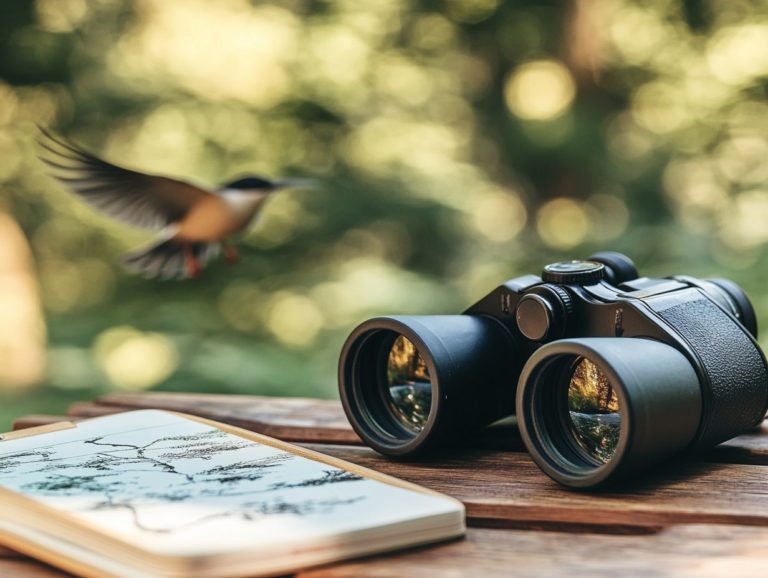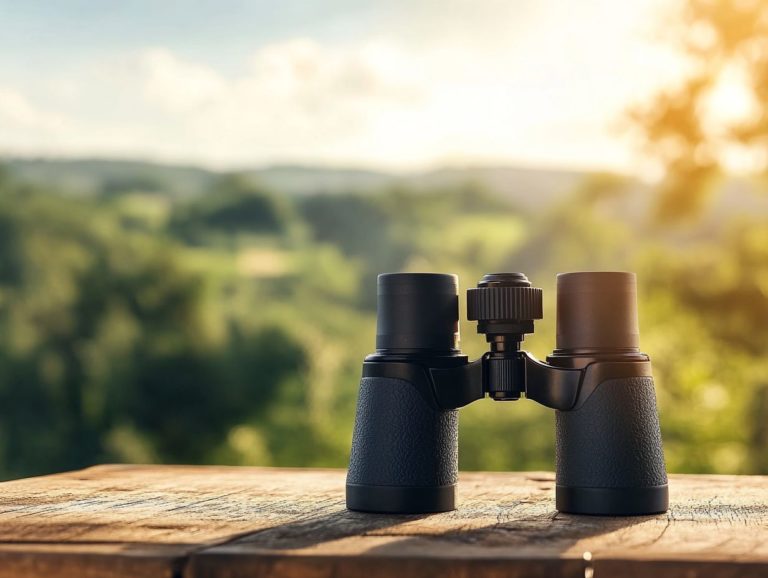How to Select Binoculars for Bird Watching Tours
Choosing the right binoculars can truly elevate your birding adventures.
With many options available, understanding the essential features is vital. Each component from magnification power to lens quality plays a significant role in shaping your viewing experience.
This guide explores key factors to consider, including ergonomics for comfort during extended use and budget-friendly options that still deliver quality.
Get ready to take your birdwatching adventures to the next level, especially for birders and ornithologists alike!
Contents
- Key Takeaways:
- Understanding the Basics of Binoculars
- Choosing the Right Magnification
- Considerations for Lens Quality
- Evaluating the Field of View
- Ergonomics and Comfort
- Budget and Price Range
- Frequently Asked Questions
- What should I consider when selecting binoculars for bird watching tours?
- What is the recommended magnification power for binoculars used in bird watching tours?
- What is the significance of the objective lens size in binoculars for bird watching tours?
- Should I prioritize a wider field of view or higher magnification when selecting binoculars for bird watching tours?
- What is a good weight range for binoculars for bird watching tours?
- Are there any features I should look for in binoculars for bird watching tours?
Key Takeaways:
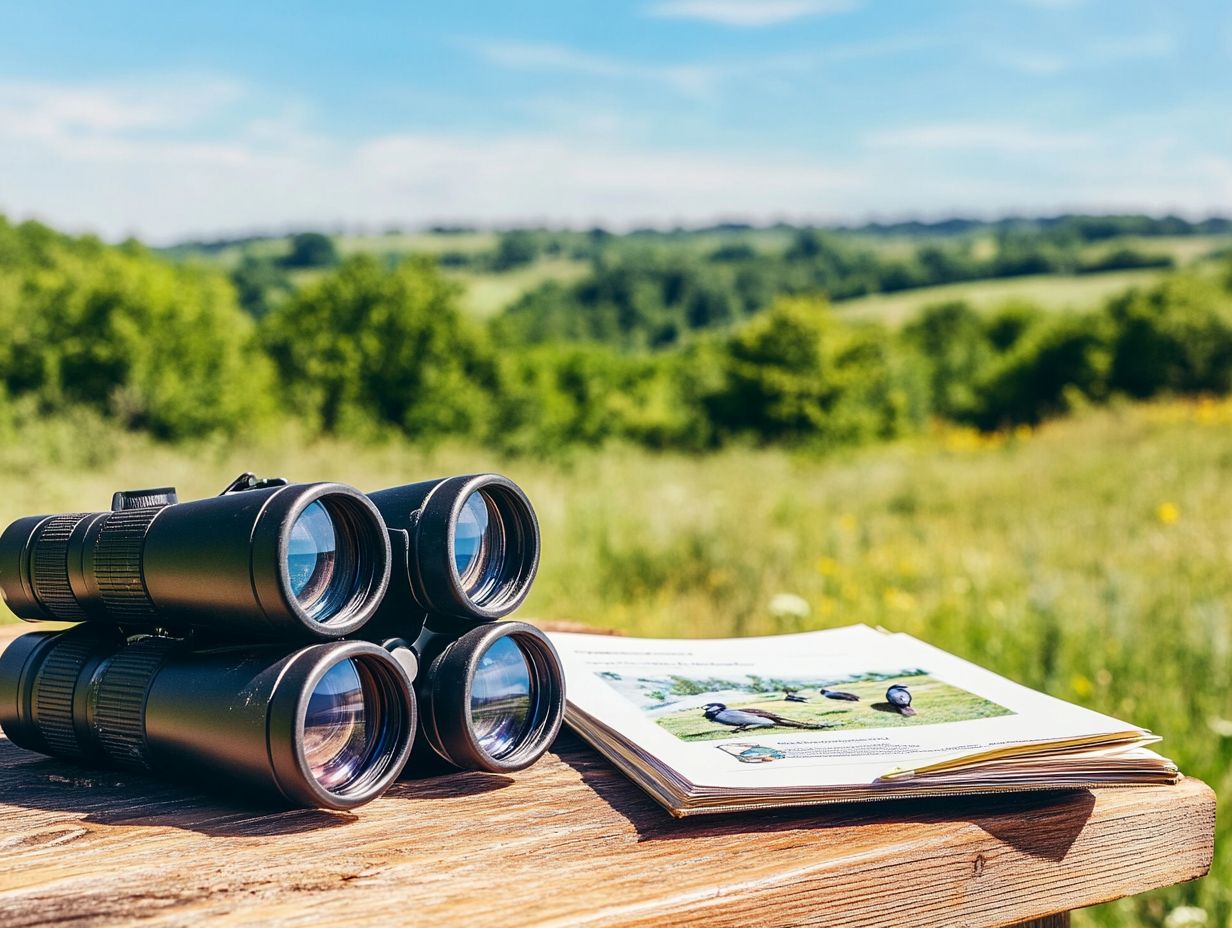
- Consider magnification, lens quality, field of view, ergonomics, and budget when choosing binoculars.
- Higher magnification isn’t always better. Choose binoculars that offer a wide field of view and are comfortable for long use.
- Lens coatings impact your birdwatching experience; look for anti-reflective coatings to reduce glare and improve clarity.
Understanding the Basics of Binoculars
Understanding the basics of binoculars is essential for enhancing your birdwatching experience. Binoculars are optical instruments that magnify distant objects, making them critical for birding enthusiasts attending events like the Audubon Convention in Milwaukee.
Each component, from the objective lens to the ergonomics, plays a crucial role in optimizing clarity, brightness, and color rendition. By grasping the differences between two common designs that determine how light enters the binoculars, you can make the right choice for a more rewarding outdoor adventure.
Parts and Features to Consider
When selecting binoculars, key components to consider include the focus wheel, diopter adjustment, and various coatings that enhance optical quality.
The focus wheel is essential for achieving sharp images, allowing you to quickly zoom in on distant subjects. Equally important is the diopter adjustment, which customizes focus according to your vision differences an invaluable feature in the field.
Understanding the different types of lens coatings can significantly improve brightness and clarity. For example, multi-coated lenses are designed to reduce glare and improve light transmission. These elements work together to enrich your experience, making it easier to spot and identify elusive bird species in their habitats.
Choosing the Right Magnification
Selecting the right magnification for your binoculars is vital for an enriching birdwatching experience, as it influences both your field of view and image stability. For those seeking affordability without sacrificing quality, check out the best binoculars for bird watching on a budget, which offer excellent options ranging from budget-friendly models to high-end varieties that provide exceptional optics and clarity.
Typically expressed in numbers such as 8x or 10x understanding these specifications enables you to make a well-informed decision tailored to your specific birding requirements.
Factors to Consider for Bird Watching
When choosing binoculars for bird watching, several factors deserve attention, such as brightness, color rendition, and eye relief. For a comprehensive overview, consider the aspects to look for when buying birding binoculars. These elements significantly enhance your viewing experience.
Each feature plays a vital role in how well you can observe your feathered friends. Brightness is essential during low-light conditions like dawn or dusk, when many birds are most active. Adequate brightness ensures that you can see the intricate details of plumage and movement, helping you spot elusive species.
Accurate color rendition is crucial for bird identification, as many species exhibit subtle color variations key to proper classification. If you wear glasses, you’ll find that eye relief is of utmost importance; it allows for comfortable viewing without sacrificing image quality.
Together, these aspects create an optimal birdwatching experience, enhancing clarity and enjoyment.
Start exploring your binocular options today and bring the beauty of nature closer than ever before!
Considerations for Lens Quality
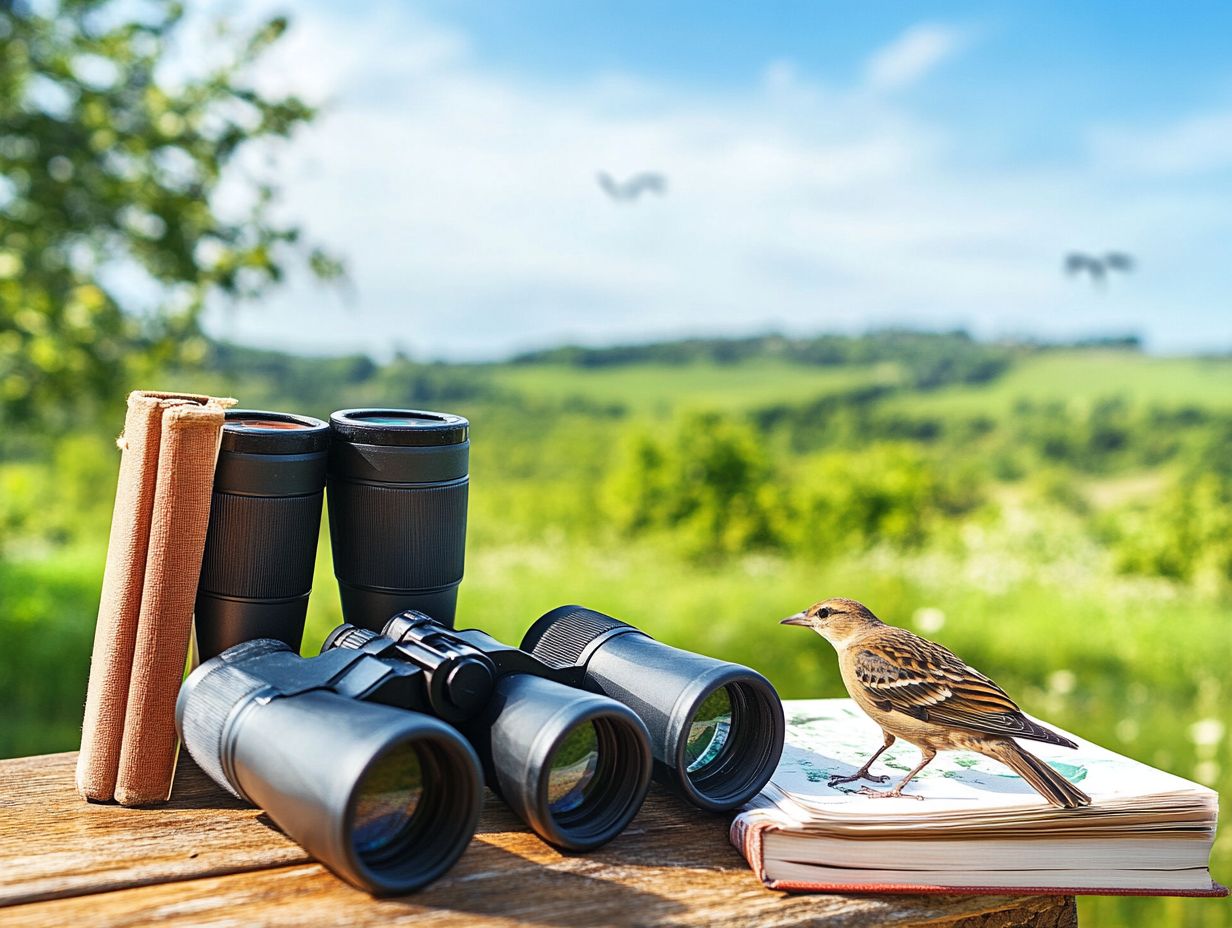
When diving into lens quality considerations for binoculars, you’ll find that the objective lens diameter the size of the lens that gathers light optical quality, and coatings are key factors influencing overall performance.
Superior objective lenses can greatly amplify brightness and clarity. This is vital for spotting those hard-to-find birds in diverse lighting conditions. Coated optics are important for minimizing light loss and enhancing color accuracy, especially those with multiple layers.
These features are game-changers for bird watchers who truly value every fine detail in their observations.
Types of Lens Coatings and Their Impact
The types of lens coatings significantly influence the brightness and clarity of your binocular optics.
Coatings, particularly anti-reflective ones, enhance light transmission by reducing glare and reflections that can obscure your view. For bird watchers like you, crystal-clear visuals are essential, especially in the shifting light of dawn or dusk when wildlife is most active.
With these advanced coatings, you can spot and identify birds with greater accuracy and detail. This makes each observation even more rewarding!
By maximizing the amount of light that reaches your eyes, these coatings add considerable value to binoculars. They transform ordinary moments into experiences filled with clarity and awe.
Evaluating the Field of View
Evaluating the field of view is essential for your birdwatching experience. It directly impacts how much area you can observe through your binoculars at any given distance, whether you are in a crowded area or a serene landscape.
A wider field of view enables you to track bird movement more easily. This is particularly crucial when you’re trying to spot birds in flight or navigating through dense foliage.
Typically measured in feet at 1,000 yards, the field of view can vary significantly between different binocular models. This makes it a vital factor for any serious birdwatching enthusiast like yourself.
Importance for Bird Watching and Other Activities
The significance of the field of view goes far beyond bird watching. It enhances clarity and brightness across a range of outdoor pursuits.
For hikers seeking to lose themselves in breathtaking landscapes or wildlife enthusiasts eager to spot animals in their natural habitat, a wider field of view is advantageous. It allows you to effortlessly scan your surroundings and catch details and movements that might otherwise slip by unnoticed.
With high-quality optics, the clarity and vibrancy of the images you observe can elevate your outing. This transforms it into a more vivid and unforgettable experience. As more outdoor enthusiasts recognize these benefits, it’s evident that versatile tools like binoculars are becoming critical for anyone aspiring to forge a deeper connection with nature.
Ergonomics and Comfort
Choosing the right binoculars means prioritizing comfort and ergonomics. This is particularly important for birders who find themselves in the field for extended periods, especially when learning how to use binoculars for bird watching in groups.
Opting for a lightweight design with weatherproof features can dramatically enhance your experience. It allows for prolonged use without succumbing to fatigue.
Binoculars that rest comfortably in your hands and offer easy adjustments like a well-placed focus wheel and diopter adjustment can elevate your long birding sessions. This leads to greater overall satisfaction!
Factors to Consider for Extended Use

When you’re on the hunt for binoculars for extended use, consider factors like weatherproofing, a lightweight design, and ergonomic grips. Additionally, knowing how to use binoculars for bird migration watching is essential for an enjoyable experience.
These elements significantly enhance your experience during long birding sessions. Weatherproofing allows you to confidently step into various outdoor conditions, knowing your equipment can handle sudden rain or humidity without a hitch.
A lightweight design makes carrying your binoculars a breeze, preventing fatigue that can pull your attention away from the beauty around you.
Ergonomic grips offer the comfort and stability you need, ensuring a secure hold that minimizes strain on your hands and wrists. Choosing these features can transform your outdoor adventures!
They directly influence usability and comfort, ultimately fostering a deeper connection with the wonders of nature.
Budget and Price Range
When selecting binoculars, budget and price range are crucial factors to consider. You ll find options ranging from affordable models around $150 to high-end variants that can soar past $2,000.
By clarifying your budget, you can streamline your choices while ensuring you don t sacrifice key features like optical quality and ergonomics elements vital for birdwatching and outdoor adventures.
Many esteemed brands present choices within the $500 to $1,000 range, striking a harmonious balance between quality and cost-effectiveness.
Finding a Balance Between Quality and Cost
Finding the perfect balance between quality and cost is essential when you’re choosing binoculars. Higher retail prices often indicate superior optical quality and reputable brand names, so it s worth paying attention.
Investing in well-regarded brands can elevate your overall experience as an enthusiast. High-quality optics typically deliver clearer images and superior light transmission critical features for activities like birdwatching, where every detail counts.
When you consider how vital sharp, vibrant visuals are for identifying diverse species and truly appreciating their beauty, it s easy to see why opting for optics backed by strong customer service brings peace of mind.
Reliable brands strive to ensure their products are built to last, ultimately enhancing your long-term satisfaction and performance efficiency.
Frequently Asked Questions
Here are some common questions to help you choose the best binoculars for bird watching.
What should I consider when selecting binoculars for bird watching tours?
When selecting binoculars for bird watching tours, consider the magnification power, objective lens size, field of view, and weight of the binoculars. These factors determine the clarity, brightness, and ease of use during your bird watching experience. For more detailed guidance, check out these tips for choosing binoculars for bird photography.
What is the recommended magnification power for binoculars used in bird watching tours?
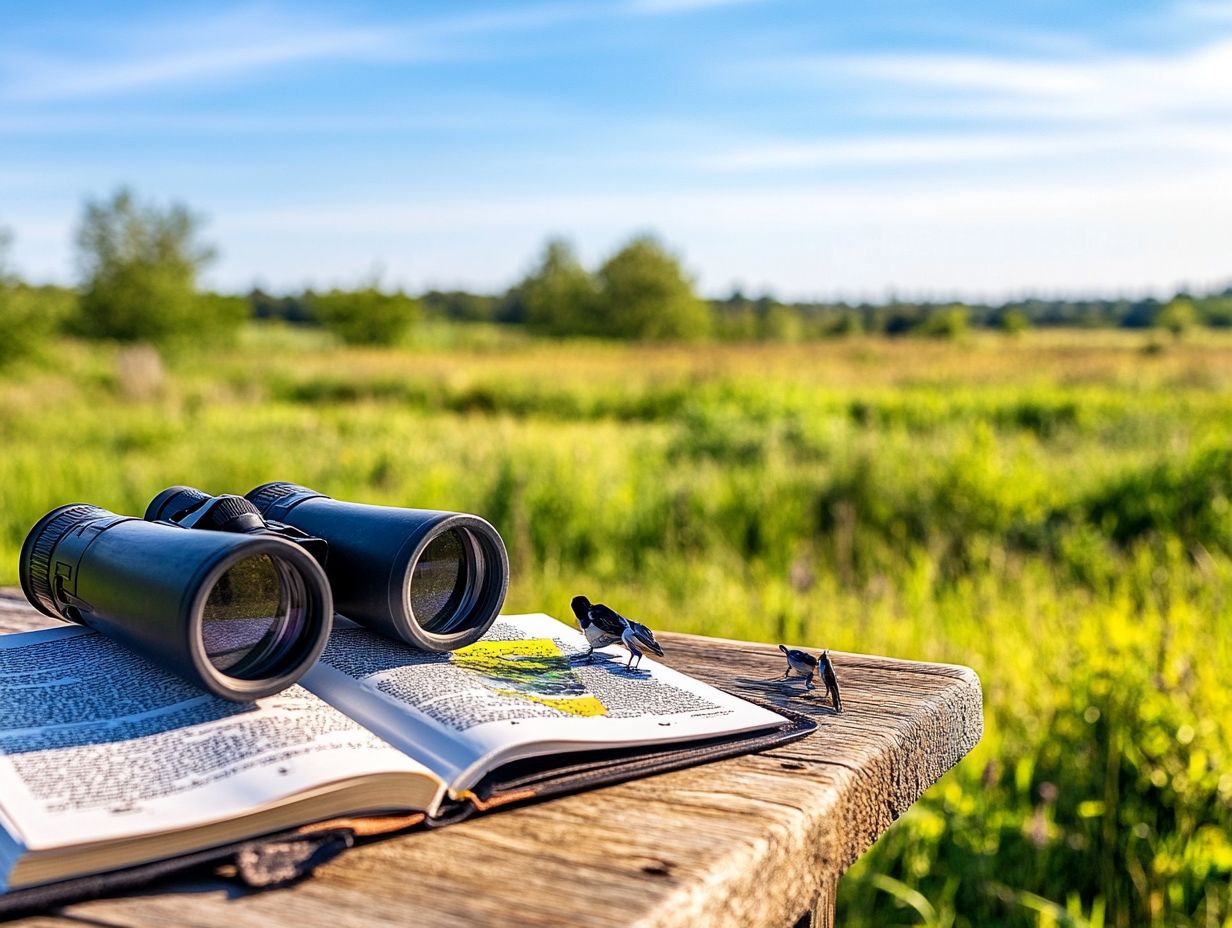
The ideal magnification power for binoculars used in bird watching tours is between 8x to 10x. This level of magnification provides a good balance between magnifying distant birds and maintaining a stable image. For more insights, check out what are the best binoculars for bird watching trips.
What is the significance of the objective lens size in binoculars for bird watching tours?
The objective lens size determines the amount of light that enters the binoculars, which affects the brightness and clarity of the image. For bird watching tours, it is recommended to have an objective lens size of 40mm or above. Additionally, consider reviewing how to select the right accessories for birding to enhance your experience.
Should I prioritize a wider field of view or higher magnification when selecting binoculars for bird watching tours?
This depends on your personal preference and the type of bird watching you will be doing. A wider field of view allows you to spot birds more easily, while higher magnification offers better details of birds. For an optimal experience, consider using the best binoculars for backyard bird watching to strike a balance between the two.
Don’t miss out on the chance to connect deeply with nature! Start your birdwatching journey today with the top binoculars for bird watching in urban areas!
What is a good weight range for binoculars for bird watching tours?
For bird watching tours, binoculars should weigh between 1 to 2 lbs. Heavier binoculars can strain your arms and neck, making it uncomfortable. To ensure a better experience, it’s helpful to learn how to use binoculars for bird watching safely.
Are there any features I should look for in binoculars for bird watching tours?
Look for features like waterproofing and fog-proofing. The ability to see birds that are very close to you can significantly improve your viewing experience, no matter the weather!




